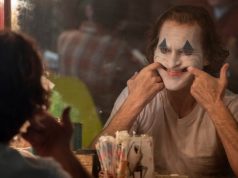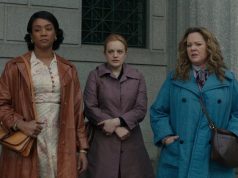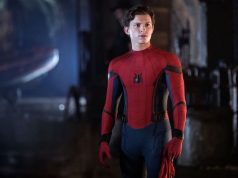In “Avengers: Age of Ultron,” the 43rd film in the Marvel Cinematic Universe®, Earth’s mightiest heroes™ must band together to squabble amongst themselves, and also to save the world from a deadly threat unleashed by, uh, themselves. The Avengers’ ultimate goal is for the world not to need them anymore, but it seems like the world will always need the Avengers as long as the Avengers are around.
The threat is Ultron, an artificial intelligence program designed by Tony Stark (Robert Downey Jr.) and semi-accidentally brought to life in a way that gives it full autonomy. Ultron was to bring about world peace, but now that it’s alive (sort of), Ultron has other, deadlier ideas. Taking the form of a muscular robot, Ultron has James Spader’s literal voice and writer-director Joss Whedon’s figurative voice. That is to say, he talks like a Joss Whedon character, all glib and slangy, like everything is a joke.
Also speaking like a Joss Whedon character: everyone else in this movie.
But you needn’t fear that Whedon has made “Age of Ultron” distinctly his own. No, it is still very much a Marvel Cinematic Universe® movie, with the same look and feel and vibe and climax (everyone fighting some big thing in the air over a city) as the rest. There is a cosmic MacGuffin that has to be kept out of villains’ hands, and a Stan Lee cameo (BE SURE TO CHEER LOUDLY WHEN YOU RECOGNIZE HIM!!!!).
“Iron Man” (2008) B
“The Incredible Hulk” (2008) B
“Iron Man 2” (2010) B-
“Thor” (2011) B
“Captain America: The First Avenger” (2011) B
“The Avengers” (2012) B+
“Iron Man 3” (2013) B+
“Thor: The Dark World” (2013) C-
“Captain America: The Winter Soldier” (2014) B
“Guardians of the Galaxy” (2014) B
“Avengers: Age of Ultron” (2015) B-
“Ant-Man” (2015) B
“Captain America: Civil War” (2016) B
“Doctor Strange” (2016) B+
“Guardians of the Galaxy Vol. 2” (2017) B-
“Spider-Man: Homecoming” (2017) B+
“Thor: Ragnarok” (2017) B
“Black Panther” (2018) B
“Avengers: Infinity War” (2018) B-
“Ant-Man and the Wasp” (2018) B
“Captain Marvel” (2019) B-
Tony Stark is at odds with Captain America (Chris Evans) over the scope of their mission. Bruce Banner (Mark Ruffalo) is dating Natasha (Scarlett Johansson), who has found a method for calming him down after Hulk episodes, though he’s still worried he can’t control himself. Thor (Chris Hemsworth) has a hammer. There’s still no need for poor Hawkeye (Jeremy Renner), but he’s here anyway. To address that issue, Whedon has someone tell him that the Avengers DO need him. This person (not one of the Avengers, crucially) doesn’t explain why or how they need him, but we’re supposed to feel like they do, because someone said it. Just take her word for it, I guess.
There are also a couple of new mutants, except we can’t call them mutants because that’s an X-Men thing, and the X-Men movies, despite being cinematic works based on characters from Marvel comic books, are not part of the Marvel Cinematic Universe®. One of them is Quicksilver (Aaron Taylor-Johnson), who moves really fast and should not be confused with the other Quicksilver who moves really fast who was in the most recent X-Men movie. These are two totally different Quicksilvers. This Quicksilver’s twin sister, Scarlet Witch (Elizabeth Olsen), is also present. She has telekinesis and other psychic powers.
I’ve basically enjoyed almost all of the Marvel Cinematic Universe® movies, especially on first viewing. (I’m a big Whedon fan, too, actually, but COME ON with the characters all sounding alike.) But cranking out so many in such a short span of time — “Iron Man” was only seven years ago — dilutes the effect of seeing superheroes dash across the big screen. The impact is weakened even further when the movies begin to take on a certain sameness to them, as the last few have done. It’s like we’re watching consecutive episodes of a very large, very expensive TV show. You might love the show, but it’s not exactly an “event” every time it’s on, you know?
So … it’s fine. A few good jokes, some decent action. Nothing surprising or very memorable. But hey, tune in next week.
B- (2 hrs., 21 min.; )





